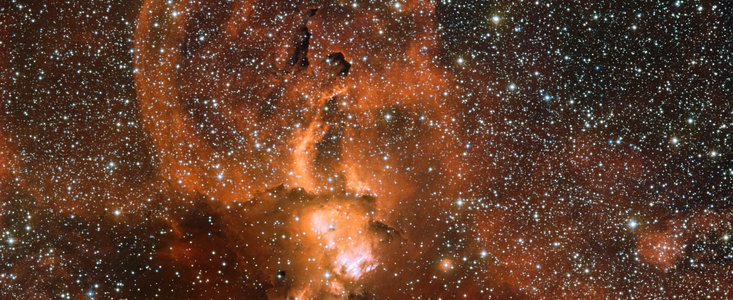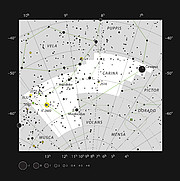Pressemeddelelse
Himmelsk fyrværkeri fra døende stjerner
13. april 2011

Dette billede af stjernetågen NGC 3582, der er optaget af Wide Field Imagager på MPG/ESO 2,2 meter teleskopet på ESO’s La Silla-observatorium i Chile, viser gigantiske buer af gas, som har en slående lighed med protuberanser på Solen. Disse buer er formentlig slynget ud af døende stjerner, men nye stjerner bliver også født i denne stjerne-fødeklinik. Disse energirige ynglinge udsender intens ultraviolet stråling, der får gassen i stjernetågen til at gløde og skaber det fyrige billede, der ses her.
NGC 3582 er en del af et større stjernedannende område i Mælkevejen, der kaldes RCW 57. Det befinder sig tæt på Mælkevejens centrale plan i det sydlige stjernebillede Carina (på dansk Kølen med henvisning til kølen på Jasons skib, Argo). John Herschel var den første til at se dette komplekse område af glødende gas og mørke støvskyer i 1834 under et ophold i Sydafrika.
Nogle af de stjerner, der dannes i områder som NGC 3582 er meget tungere end Solen. Disse monster-stjerner udsender enorme mængder af energi og har meget korte liv, der ender i eksplosioner, som kaldes supernovaer. Det materiale, der bliver slynget ud fra disse dramatiske begivenheder, skaber bobler i omkringliggende gas og støv. Det er den sandsynlige årsag til de buer, der ses på dette billede.
Billedet er en kombination af optagelser gennem flere forskellige filtre. Fra Wide Field Imager er data optaget gennem et rødt filter gengivet i grønne og røde farver. Data optaget gennem et filter, der isolerer den karakteristiske røde glød fra brint, er også gengivet i røde farver. Yderligere infrarøde data fra Digitized Sky Survey er gengivet i blå farver.
Billedet er fremstillet af ESO ved brug af data fra observationer, der er fundet frem af Joe DePasquale fra USA [1], da han deltog i astrofoto-konkurrencen ”ESO’s Skjulte Skatte 2010” [2]. Konkurrencen blev organiseret af ESO i oktober-november 2010 og var for alle, der nyder at lave smukke billeder af nattehimlen ved hjælp af astronomiske data, som er optaget gennem professionelle teleskoper.
Noter
[1] Joe gennemsøgte ESO’s arkiver og fandt datasæt, som han brugte til at komponere sit billede af NGC 3582, der fik en samlet tiendeplads i konkurrencen ud af næsten 100 bidrag. Hans originale bidrag kan ses her.
[2] Astrofoto-konkurrencen ”ESO’s Skjulte Skatte 2010” gav amatørastronomer mulighed for at gennemgå ESO’s enorme arkiv af astronomiske data i håbet om at finde en skjult kosmisk perle, der havde behov for nænsom polering. Læs mere om ”ESO’s Skjulte Skatte 2010” her.
Mere information
ESO, det Europæiske Syd Observatorium, er den mest fremtrædende internationale astronomi-organisation i Europa og verdens mest produktive astronomiske observatorium. ESO har i dag følgende 14 medlemslande: Belgien, Danmark, Finland, Frankrig, Holland, Italien, Portugal, Schweiz og Storbritannien, Spanien, Sverige, Tjekkiet, Tyskland og Østrig. Flere lande har udtrykt interesse i medlemskab. ESO’s aktiviteter er fokuseret på design, konstruktion og drift af jordbaserede observationsfaciliteter for astronomi for at muliggøre vigtige videnskabelige opdagelser. ESO spiller også en ledende rolle for at fremme og organisere samarbejdet inden for astronomisk forskning. I Chile driver ESO tre unikke observatorier i verdensklasse: La Silla, Paranal og Chajnantor. På Paranal driver ESO Very Large Telescope (VLT), der er verdens mest avancerede astronomiske observatorium til observationer i synligt lys. ESO er den europæiske partner i et revolutionerede astronomisk teleskop kaldet ALMA, det største igangværende astronomiske projekt. ESO planlægger i øjeblikket et 42 meter optisk/nær-infrarødt teleskop kaldet European Extremely Large Telescope (E-ELT), der vil blive ”verdens største øje mod himlen”.
Links
Kontakter
Richard Hook
ESO, La Silla, Paranal, E-ELT and Survey Telescopes Public Information Officer
Garching bei München, Germany
Tel: +49 89 3200 6655
Mobil: +49 151 1537 3591
E-mail: rhook@eso.org
Ole J. Knudsen (Pressekontakt Danmark)
ESOs formidlingsnetværk
og Aarhus Space Centre, Aarhus Universitet
Aarhus, Danmark
Tel: +45 8715 5597
E-mail: eson-denmark@eso.org
Om pressemeddelelsen
| Pressemeddelelse nr.: | eso1113da |
| Navn: | NGC 3582 |
| Type: | Milky Way : Nebula : Type : Star Formation |
| Facility: | MPG/ESO 2.2-metre telescope |
| Instruments: | WFI |
Our use of Cookies
We use cookies that are essential for accessing our websites and using our services. We also use cookies to analyse, measure and improve our websites’ performance, to enable content sharing via social media and to display media content hosted on third-party platforms.
ESO Cookies Policy
The European Organisation for Astronomical Research in the Southern Hemisphere (ESO) is the pre-eminent intergovernmental science and technology organisation in astronomy. It carries out an ambitious programme focused on the design, construction and operation of powerful ground-based observing facilities for astronomy.
This Cookies Policy is intended to provide clarity by outlining the cookies used on the ESO public websites, their functions, the options you have for controlling them, and the ways you can contact us for additional details.
What are cookies?
Cookies are small pieces of data stored on your device by websites you visit. They serve various purposes, such as remembering login credentials and preferences and enhance your browsing experience.
Categories of cookies we use
Essential cookies (always active): These cookies are strictly necessary for the proper functioning of our website. Without these cookies, the website cannot operate correctly, and certain services, such as logging in or accessing secure areas, may not be available; because they are essential for the website’s operation, they cannot be disabled.
Functional Cookies: These cookies enhance your browsing experience by enabling additional features and personalization, such as remembering your preferences and settings. While not strictly necessary for the website to function, they improve usability and convenience; these cookies are only placed if you provide your consent.
Analytics cookies: These cookies collect information about how visitors interact with our website, such as which pages are visited most often and how users navigate the site. This data helps us improve website performance, optimize content, and enhance the user experience; these cookies are only placed if you provide your consent. We use the following analytics cookies.
Matomo Cookies:
This website uses Matomo (formerly Piwik), an open source software which enables the statistical analysis of website visits. Matomo uses cookies (text files) which are saved on your computer and which allow us to analyze how you use our website. The website user information generated by the cookies will only be saved on the servers of our IT Department. We use this information to analyze www.eso.org visits and to prepare reports on website activities. These data will not be disclosed to third parties.
On behalf of ESO, Matomo will use this information for the purpose of evaluating your use of the website, compiling reports on website activity and providing other services relating to website activity and internet usage.
Matomo cookies settings:
Additional Third-party cookies on ESO websites: some of our pages display content from external providers, e.g. YouTube.
Such third-party services are outside of ESO control and may, at any time, change their terms of service, use of cookies, etc.
YouTube: Some videos on the ESO website are embedded from ESO’s official YouTube channel. We have enabled YouTube’s privacy-enhanced mode, meaning that no cookies are set unless the user actively clicks on the video to play it. Additionally, in this mode, YouTube does not store any personally identifiable cookie data for embedded video playbacks. For more details, please refer to YouTube’s embedding videos information page.
Cookies can also be classified based on the following elements.
Regarding the domain, there are:
- First-party cookies, set by the website you are currently visiting. They are stored by the same domain that you are browsing and are used to enhance your experience on that site;
- Third-party cookies, set by a domain other than the one you are currently visiting.
As for their duration, cookies can be:
- Browser-session cookies, which are deleted when the user closes the browser;
- Stored cookies, which stay on the user's device for a predetermined period of time.
How to manage cookies
Cookie settings: You can modify your cookie choices for the ESO webpages at any time by clicking on the link Cookie settings at the bottom of any page.
In your browser: If you wish to delete cookies or instruct your browser to delete or block cookies by default, please visit the help pages of your browser:
Please be aware that if you delete or decline cookies, certain functionalities of our website may be not be available and your browsing experience may be affected.
You can set most browsers to prevent any cookies being placed on your device, but you may then have to manually adjust some preferences every time you visit a site/page. And some services and functionalities may not work properly at all (e.g. profile logging-in, shop check out).
Updates to the ESO Cookies Policy
The ESO Cookies Policy may be subject to future updates, which will be made available on this page.
Additional information
For any queries related to cookies, please contact: pdprATesoDOTorg.
As ESO public webpages are managed by our Department of Communication, your questions will be dealt with the support of the said Department.



